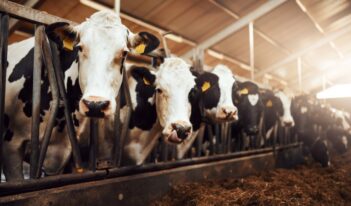
Legal scholar argues for a new strategy to challenge animal farm pollution.
Environmentalists and farmers will argue about pollution regulation until the cows come home, with environmentalists seeking more regulations and farmers seeking more exemptions.
But how can environmental advocates challenge industrial animal production?
One legal scholar argues that environmental advocates need to take the regulatory bull by the horns and use a different strategy for change.
In her paper, Julia McCarthy, senior policy associate at the Center for Science in the Public Interest, examines the ways in which environmental advocates could address pollution from concentrated animal feeding operations by filing a legal challenge to the National School Lunch Program (NSLP).
McCarthy notes that the federal government is the largest purchaser of factory farm food and annually spends billions on this food for the NSLP. The program’s aim is to supply healthy, low-cost lunches for children while also supporting the agricultural industry, she writes.
Through the program, USDA provides school districts with food to encourage the consumption of domestic farm products. USDA’s Food and Nutrition Service (FNS) provides a list of which foods are available for purchase. McCarthy states that, in 2015, FNS purchased more than $859 million in animal products for the school lunch program—about 55 percent of the program’s food costs.
McCarthy also notes that the U.S. Department of Agriculture (USDA) skipped a National Environmental Policy Act (NEPA) review—which requires federal agencies to investigate the environmental effects of major agency action—and also failed to complete an environmental impact statement. She argues that advocates should challenge this decision to forgo NEPA review and also petition USDA to complete an impact statement for the program.
The industrial animal agriculture system has a huge waste and pollution problem and the system contributes to significant water and air pollution, argues McCarthy. The U.S. Environmental Protection Agency (EPA) does not require sewage treatment plants to treat animal waste, and farmers crowd animals into closely packed feeding facilities to minimize costs.
From these facilities, farm owners drain debris, including feces, urine, hair, carcasses, and bedding, into “manure lagoons,” home to such contaminants as E. coli, growth hormones, antibiotics, chemicals, phosphorous, and nitrogen, among others. These untreated manure lagoons pollute both surface and ground waters, maintains McCarthy. She notes that chemicals and gases like phosphorous, nitrogen, and hormones leach into waterways and destroy aquatic life. Fecal bacteria and pathogens from the manure lagoons similarly spill out and negatively impact varied water uses such as recreational swimming and the harvesting of seafood for consumption, she writes.
Concentrated animal feedlots also contribute to air pollution. McCarthy contends that these operations are responsible for nearly 75 percent of the nation’s ammonia emissions. McCarthy notes that there was a 64 percent increase in methane and nitrous emissions from 1990 to 2015, and she links this jump to the development of concentrated feeding operations. She also states that agricultural emissions make up 10 percent of U.S. greenhouse gas production.
Furthermore, McCarthy argues that the extensive use of antibiotics on animals for preventative reasons results in antibiotic treatments becoming resistant to bacteria and less effective for humans.
McCarthy maintains that all of these factors lead to increased risks from eating domestic animal products, the same products purchased in bulk by USDA for the NSLP. But she argues that in the existing regulatory system, farms enjoy significant freedom from environmental regulation. As a result of farm lobbying efforts, many regulations either expressly exempt farming or limit only the largest agricultural polluters, and McCarthy contends that federal and state laws are similarly ineffective for regulating pollution.
McCarthy holds that federal environmental laws have not kept up with the modern intensification of animal production. For example, the Clean Water Act prevents pollutant discharge into waterways, but it limits regulation to only the largest industrial animal farms and only certain activities. As a result, it does not regulate most agricultural water pollution, she argues.
Another example McCarthy notes is the Clean Air Act, which protects the quality of the nation’s air resources. She claims that although the Act orders EPA to establish air quality standards for air pollutants, EPA did so for only one air pollutant which industrial animal farms produce, and not for ammonia, the most common animal farm pollutant.
To complicate matters further, McCarthy writes that state nuisance laws also prevent environmentalists from addressing pollution. She emphasizes that many legislatures have passed laws to deter private nuisance claims, such as laws to cap damages or “right to farm” laws that provide an irrebuttable presumption that there is no nuisance.
To counteract these ineffective federal and state environmental regulations, McCarthy argues that environmentalists should petition USDA to complete an environmental impact statement on how much pollution the lunch program causes, and that legal advocates should challenge USDA’s failure to conduct NEPA review.
McCarthy contends that USDA does not categorically exempt the NSLP from NEPA review. USDA regulations exclude certain activities from NEPA, but McCarthy maintains that the lunch program activities are significantly broader and not exempted. In fact, she asserts that USDA regulation requires agencies to reconsider categorical exclusions in light of new evidence, and she claims that the continuing evidence of pollution reinforces the need for NEPA review.
Because the school lunch program is not exempt from NEPA review, USDA should complete an environmental impact statement, according to McCarthy. She argues that an environmental impact statement would provide an important opportunity for both other agencies and affected communities to provide meaningful feedback on the use of industrial animal products.



